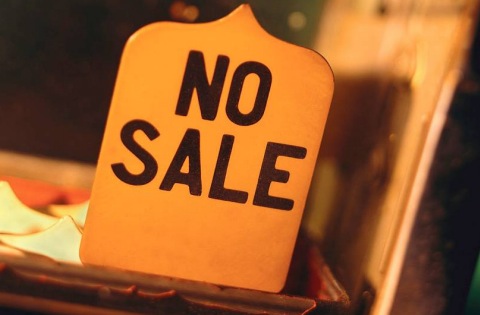01 Nov 2013
3 Signs You Are About To Lose The Sale
 Like most of you, I get cold calls and e-mails every day. 98% of it is spam – offers for things I have no interest in, or don’t need. Only 2% are even relevant to me or my business and unfortunately, most of those don’t get my attention either (so they inadvertently lose the sale).
Like most of you, I get cold calls and e-mails every day. 98% of it is spam – offers for things I have no interest in, or don’t need. Only 2% are even relevant to me or my business and unfortunately, most of those don’t get my attention either (so they inadvertently lose the sale).
Truth be told, I almost never answer or respond and I’m sure you feel the exact same way. It’s not because I have it in for salespeople – although most of us will admit we cringe at the hard sell tactics of the stereotypical salesperson. It’s because the vast majority of salespeople completely blow their initial approach and fail to capture my interest.
Now I appreciate and respect the fact that these people are just trying to do their jobs and make a living. Selling is not a crime. In fact, we are ALL in the business of selling something – a product, a service, an idea, a lifestyle, a belief, or a cause. So, like you, I’m not insensitive to the plight of the honest, hardworking sales professional.
The problem is this – most of their hard work (and yours) often goes to waste when they lose the sale for reasons that are preventable. They end up turning me off their product or whatever it is they’re selling because I am either bored, confused or overwhelmed by the pitch. And this usually shows up in one of three classic responses that I give, which I’m sure you have heard (or given) before. These are telltale cues that they (or you) are about to lose the sale:
- This isn’t a good time for me,
- I need to think about it, or
- Leave it with me and I will go over it later.
Fortunately, the mistakes that produced these 3 classic responses are completely avoidable – mistakes that you don’t have to make (and lose the sale) once you discover how the brain of your prospect hears your message and what you need to do to help him make a decision quickly.
The first and most important step in creating a sales or marketing message that closes more business is to become an expert at capturing attention up-front. If you are successful at quickly and strongly enchanting your prospect within the first 60 seconds, you stand a much greater chance of holding his interest until you can communicate your entire message.
Regardless of the length of your sales presentation or marketing message, you must capture attention and deliver your most powerful points up-front when your audience is most alert and receptive. Never begin by introducing your brand, building your credibility, talking about your competitors, or listing features and benefits. This strategy will put your customers to sleep (cause you to lose the sale) and you risk having to deliver your most important claims and proof when your customers are least likely to remember them.
In order to capture the attention of your audience and hold it, you have to know the one thing that is MOST important to them right now. This is something that you cannot afford to guess or assume. In order to make the greatest impact and charm the old brain of your customer, you need to do your homework up-front. You can’t afford the luxury of pitching five or six features/benefits and hope that one of them will appeal or hit the mark.
By taking the time upfront to help your prospect understand, acknowledge, and quantify his #1 source of pain, he will become clear about the true source and intensity of this problem, and you will reinforce (with his old brain) that it is safe to trust you and your proposed solution. Failing to do so, will inevitably lead to the undesired result of causing you to lose the sale and waste your valuable time and money in the process.
 Not that long ago, I received a 15-page sales letter from a self-proclaimed small business marketing expert trying to convince me to attend his latest seminar. I was actually blown away at how bad the letter was… and how mind numbing.
Not that long ago, I received a 15-page sales letter from a self-proclaimed small business marketing expert trying to convince me to attend his latest seminar. I was actually blown away at how bad the letter was… and how mind numbing.
Part of what struck me as both humorous and shocking was that he claimed to be an expert in neuromarketing (and small business marketing). Ironically, there is a vast amount of neuroscientific research that proves the average human attention span is incredibly short and that all decisions are dominated by the oldest and most primitive part of the brain – the old or reptilian brain.
So if the decision-making part of your brain is incredibly hasty and primarily driven by survival instincts, what are the chances that either you or I would wade through 15 pages of self-indulgent copy to decide whether or not we want to attend a seminar? Odds are slim, aren’t they?
What Do Successful Small Business Marketing Professionals Do to Compel Prospects to Say “Yes”?
If you are interested in more articles to help you boost the effectiveness of your small business marketing today, then you will definitely want to read the following blog posts:
Is There a Better Way to Find More Customers?
Snagging more customers with a good small business marketing message doesn’t have to be tedious, expensive and stressful. Amen, right? So, let’s break it down. When you’re hungry, which would you prefer: (1) to run to the fridge and grab a tasty snack; or (2) grab your fishing pole, and head out back to catch your next meal?
How to Know Which Half of Your Advertising Budget is Wasted
John Wannamaker may not be a household name but he opened the first department store in Philadelphia in the late 1800’s and is believed to be the inventor of the price tag and the seasonal sale. He was the first retailer to place a half-page newspaper ad, and also the first full-page ad five years later. He is widely considered to be one of the fore-fathers of advertising and credited with the famous phrase: “Half the money I spend on advertising is wasted; the trouble is, I don’t know which half.”
Why with all we’ve accomplished in the last one hundred and twenty years, is this quote still relevant and significant to you (and to all small business marketing professinals) today?
 All of the leading experts recommend that you spend 75% of your budget to retaining existing customers (and re-engage them). Yet surprisingly, most companies do the exact opposite. Even large corporations like Coles, Woolworths, Max Factor and Target (not just the little SMEs) make the mistake of spending too much chasing new customers (or ones that have left) and often ignore their existing ones.
All of the leading experts recommend that you spend 75% of your budget to retaining existing customers (and re-engage them). Yet surprisingly, most companies do the exact opposite. Even large corporations like Coles, Woolworths, Max Factor and Target (not just the little SMEs) make the mistake of spending too much chasing new customers (or ones that have left) and often ignore their existing ones.
Several years ago I held a senior commercial role at one of the largest retail businesses in the country and I can confirm that they spent <20% to retain existing customers. They, like 95% of businesses out there, spend the bulk of their budget on chasing new customers or attempting to re-engage those that have left and gone to the competition.
And therein lies the biggest mistake you can make as a business owner…
Every dollar spent on direct marketing to retain existing customers is actually worth 50x the equivalent amount spent chasing new customers. With above the line advertising, it is very hard to capture the attention of new customers, embed your message in their mind and compel them to act. It is much easier (and cheaper) to reinforce your message with an existing customer and encourage repeat visits.
So, if everyone knows it is easier and cheaper, why are most businesses NOT focusing the majority of their attention and budget on their existing customer base? The answer to that question is unclear. But what is clear is that there are 4 Simple Strategies that you can use today to boost sales and retain existing customers.
1. Spend 75% of Your Budget on Existing Customers – The bulk of sales and marketing efforts should be focused on direct communications and NOT on social media, newspapers, PR, magazines or pay-per-click advertising. For those of you who are established and have been in business for a few years, this is going to free up a lot of time that has been wasted on chasing new customers.
2. Do Your Homework to Maximize Return on Investment (ROI) – I recommend that you take the time today to analyse your existing customer data:
- What are they buying?
- What could you introduce them to which would increase gross profit margin?
- How can you drive frequency (visits)?
3. Frequency Lifts Sales by 75% More Than Upselling – It is much more effective and profitable, to focus on getting customers to return to your website or business, as opposed to trying to sell them one more thing while they are there.
4. Focus on Customers Within a 10km radius – Customers who have moved outside a 10km radius of your business can be particularly tricky to re-engage. In research conducted at one of the largest retailers in the country, we discovered that 82% of the revenues were attributable to customers that lived within a 10km radius. And in my experience working with hundreds of small-midsized businesses, this statistic still holds true. If your customer has moved outside of this radius, it does not make sense to waste any of your budget trying to reactivate them.
Even though it’s important to appeal to and attract new customers, it’s absolutely crucial to your business’s survival that you retain and nurture the customers that have supported and shopped with you to date. Everyone knows that is cheaper and easier to garner incremental business from existing customers but what separates the truly successful entrepreneur from the pack is the ability to put this knowledge into practice by allocating a large portion of your budget and focus to existing customers.
 “I’m your biggest fan, I’ll follow you until you love me
“I’m your biggest fan, I’ll follow you until you love me
Papa, paparazzi
Baby, there’s no other superstar, you know that I’ll be
Your papa, paparazzi”
In today’s challenging business environment, customers demand more from the products and services they buy—they want what they want, when and how they want it. And if they do not get it from you, they can and will obtain it from one of your competitors. Therefore, creating raving fans—customers who love what you do and are willing to follow, listen and respond to your call(s) to action —can give you a significant strategic advantage and improve your bottom line.
Now some of you may be wondering “what does Lady GaGa have to do with best business and branding tactics?” She’s never attended business school nor does she have a history of entrepreneurship. While it is easy to question her outlandish costumes, her repetitive child-like lyrics, and her over-the-top media stunts, it is hard to ignore her obvious musical talent and her ability to be at the right place at the right time with the right tune. Whether you love or hate her (and 99% of you are definitely in one camp or another), it is difficult to ignore the tremendous achievements (and raving fans) of this branding genius.
Less than a few years ago, she was virtually unknown – and today she has two platinum selling albums and is the envy of artists that have been in the business for decades.
How did she do it?
Think about it… in an industry cluttered with talented artists and interesting material, somehow SHE has managed to rise above almost everyone else and command our undivided attention. From her meteoric rise, we can glean 7 simple, yet powerful secrets that any business can use to create raving fans and dominate their market niche.
Secret # 1: Be Memorable
Every newspaper, radio station and TV program in the world reported and talked about the “meat dress” that Lady GaGa wore to the 2010 MTV Music awards.
To be frank, it was so bizarre and scandalous, you could not help but notice her.
Similarly, in business, it’s all about grabbing attention – about creating anticipation, capturing awareness and making customers notice your products and services. The aim is to inspire customers and potential clients stop in their tracks and pay attention to your offer, service, product, or information. In order to achieve this, you need to ask yourself what it is [exactly] about your offering (tangible or intangible) that will capture attention?
If you’re not truly memorable in business, it means you will have to work harder to get the sale. And every time you have to work harder, it costs you time and money.
Case in point – does anybody even remember (or care) what Myley Cyrus or Britney Spears wore to the MTV awards?
No. That is exactly my point – the # 1 secret to creating raving fans is to be memorable.
Secret # 2: Repeat Repeat Repeat
Lady Gaga has got some really interesting songs but when you actually look at the lyrics — they are incredibly child-like and simple. In fact, she often repeats the same words or sounds over and over again.
“Rah, rah, ah, ah, ah
Roma, roma, ma
Gaga, ooh la la
Want your bad romance
I want your ugly, I want your disease
I want your everything as long as it’s free
I want your love
Love, love, love, I want your love”
Ok Gaga, we get it already, you want our love. And love [to her] likely means HUGE album sales or — money, money, money! After all, didn’t ABBA teach us in the 80’s that it’s a rich man’s world?
So we all know that repetition works in music but why is it so powerful in business?
Each and every day, your target audience would be bombarded with hundreds of thousands of marketing messages. In order to create cut through and present a clear and coherent brand message, your message has to be the same every single time someone experiences it. To be effective, you cannot afford to be all things to all people. In this case, you actually want to be a broken record – “ tell them what you are going to tell them; then, tell it them, and finally tell them what you have told them.”
Once you have determined what your unique message is, the key is to repeat it over and over and over again – in your telephone greeting, brochures, business cards, website, Twitter account, Facebook page, Linkedin profile, press releases, thank you cards, customer feedback surveys etc.
Rarely will a customer act on your message the first time he/she sees it. If you want to earn their love, their business and create raving fans, you need to ask over and over again.
Secret # 3: Cultivate Excellence
If what you do is “just ok”, you might as well forget about being truly successful. Technical competence is the cornerstone of every thriving business.
Even Lady GaGa – as strange as she may seem – is a technical genius in her area. At the age of 4 she learned to play the piano by ear. By age 14, she’d written her first ballad and played at open mike nights in various New York clubs. At the age 20 (long before her own debut album was released) she had already written songs for many other well known artists.
Think about the most successful businesses and brand names in the World – Apple, Microsoft, Toyota, Proctor and Gamble, GE and 3M – they ALL place a huge emphasis on technical expertise and acumen. When what you do is superior to your competitors in terms of quality, service, aesthetics and durability, customers and raving fans will flock to your business and price will not be the determining factor in their decision to purchase from you.
Secret # 4: Encourage Fanatics
Lady GaGa initially focused on and won over the gay community and turned them into brand evangelists. Her music has now gained mass appeal with people of all ages and all walks of like.
Her strategy mirrored that of another well known brand icon that most people are very familiar with – Apple. If you think back a few years, Apple was very specific about who they were targeting – graphic designers, technical specialists, the music industry etc. Few people outside this narrow scope even considered owning one because it was thought to be more difficult than a PC to operate (for the average person). Now with the domination of other Apple products like the iPhone, iTunes, iPad and the iPod, almost every one of us has bought or used something that Apple produces.
If you want your business to be successful and endure the test of time, you will need to choose your demographic wisely and cultivate their fanaticism vigilantly.
Secret # 5: Focus
Are you clear about HOW your product/service makes life better for your customer?
It’s not enough to focus on being the #1 provider of this or that or the largest producer of X or Y. Success is less about size and more about companies who put the needs of their customers first. Focus first on what you can be best in the world at doing and then second on how you can deliver that world class product or service to your clients. There’s no point being bigger if what you do just isn’t that great in the first place.
As strange and outlandish as Lady GaGa is, it’s pretty clear what her focus is – delivering catching dance tunes and simple, memorable melodies. There is no tricky math here – she’s not trying to deliver deeply profound political statements or become the world’s most prolific artist. She’s just trying to do one thing – to be memorable and infectious — and she does that one thing very well.
Secret # 6: Package wisely
I have no idea how much time and effort would be spent producing the tracks that Lady GaGa releases but I would hazard a guess that almost as much is invested in developing her elaborate costumes. We all know that in life, “size matters”: In business, “packaging matters”. In fact some brands have such distinctive packaging, that they have changed the way that the entire industry displays its wares.
Think about how McDonald’s switched from Styrofoam boxes to plain wrap paper back in the early 90’s and the rest of the industry followed suit. What about the clean, vivid, minimalistic and colourful packaging of Apple? Haven’t many electronics competitors tried to mimic that highly compelling look and feel?
When is the last time that you took a step back and really looked at your packaging? Does it present your goods and services in the best light possible? If you changed its fit, shape, size, colour, directness or ease of use, could it make it easier for your customers and lift sales?
Secret # 7: Be Relentless
There are very few one-hit wonders in the music industry.
However, the world is littered with businesses that have had initial success with a product/service and then failed to do much of anything else. The advent of the internet and global trading has meant that competition is fierce in most industries and the market is inundated with new products and innovations. In order to be successful, businesses must constantly improve what they do and move forward, not only to thrive, but also to survive. To do this, you need to constantly ask yourself “what do we need to do today in order to WOW our customers and maintain their loyalty?” You need to create raving fans.
Lady GaGa does continuous improvement better than anyone. Just when one of her hits starts to taper off, she is quick to introduce us to another song that we just can’t seem to get out of our heads. In order to keep her name and brand on our minds, she carefully and consistently plans to release a new song every three to four months.
Let’s be frank, I doubt Lady Gaga will ever be invited to lecture at an Ivy League school on business success but these 7 secrets – that she does better than almost anyone else – apply to any and all businesses looking to create raving fans and be successful in today’s highly challenging and demanding marketplace.
 Today I want to share with you 2 things that you should never do/include in your sales or marketing message, if you want to get more customers to your business.
Today I want to share with you 2 things that you should never do/include in your sales or marketing message, if you want to get more customers to your business.
To prove my point, I’m going to share with you two examples of what NOT to do.
I saw a billboard recently on a major freeway. It read “Texting While Driving KILLS”. Then down below in fine print were the words “For more driving tips, text ‘SAFETY’ to 79191.” Now I’m sure you are probably laughing or at least smiling right now because this is an obvious case of sending a mixed message. And you’re right, I’m sure it is very clear to you why this message is ineffective. But the sad part is – this type of miscommunication or presentation of conflicting ideas is seeping in and polluting your sales and marketing materials every day. To get more customers to your business, you have to stop making this costly mistake.
Take for example your website, your eNewsletter or your brochure/catalog. What exactly are you asking your prospect or customer to do? Did you make the mistake of trying to cram 3 or 4 competing requests onto one page? Did you ask them to buy your product, join your database, visit your blog and watch your latest video? Chances are, you got really excited about what you do and you wanted to share everything you could on just that one tiny page. And I can understand why you got excited but you confused your audience and most of them walked away because what you wanted them to do wasn’t clear.
Now what you did may not have been as blatant as “For more driving tips, text ‘SAFETY’ to 79191.” However, the end result was the same.
If you want to get more customers and prospects to your business, you need to focus on communicating one clear message. If your message is clear and there is only one action that they could take, you will find that the number of people who step forward and take that desired action will go up dramatically.
Now that brings me to my second point.
The second mistake I don’t want you make is to use words or sentences that are confusing. Take for example this sign I saw outside a motel – “Free Wifi Starting at $59.99”. I think the motel owner who put up this sign was either in a rush or ran out of space because he forgot a few important words. What he probably meant to say was “Free Wifi. Rooms starting from $59.99”. He only forgot two small words but those simple words made the difference between a message that was clear and one that made absolutely no sense at all.
Now you may not be offering free wifi but I bet you may have used or at least seen terms like “scalable architecture”, “a customer-centric model”, “ holistic approach” or “results-based focus”. These words mean nothing to the reptilian brain (the part of your customer’s brain that decides and takes action). That part of the brain is 45million years old and it struggles to process and understand complex words, numbers, unfamiliar symbols and graphs that contain too much information. If you want to speed up the decoding process and make it easier to get more customers to your business, you need to make your message simple. Choose words that are clear and easy to understand. Complete your thoughts and sentences – don’t make it difficult and give your customer the excuse – “I need to think about it”. If your customer has too think too hard to decode your message, he simply won’t make a decision
Now I want you to be honest with yourself – is there a chance you might be sending mixed messages to your potential customers? Are your sales/marketing messages clear and succinct? If not, now is the best time to go back and re-write your materials. If you want to get more customers to your business, you need to simplify what you are asking them to do and use language that is easy to interpret.













